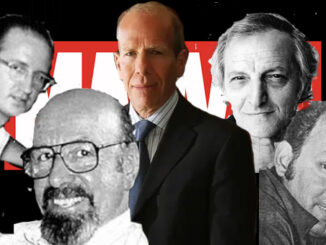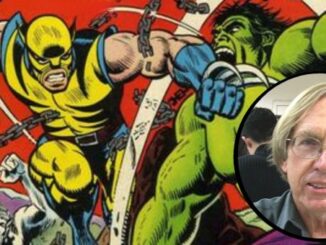
Stop me if this sounds familiar. You are a creator at Marvel and/or DC. You are feeling stifled by your work for those companies and wish you could create something vibrant and new. Something free from and editorial mandate or corporate servitude. Something where you would own the rights to what you create. So you gather a bunch of your friends and acquaintances–some of the hottest creators at the time–and decide to go in business for yourself.
For many comic fans, that is the story of Image Comics in a nutshell. But 18 years before that, it was also the story of Mike Friedrich and Star*Reach.
 Mike Friedrich was a comic book writer who got his start at DC Comics in 1968. The first work of his that DC bought was a Robin back up that appeared in Batman #202 but through the wacky way scheduling worked back in those days, his first published story in comics was “Prelude” in The Spectre #3 followed two days later by the lead story in Batman #200, “The Man Who Radiated Fear.” This was a rather high-profile debut for Friedrich, as the Spectre story reintroduced Golden Age superhero Wildcat to modern audience and Batman #200 was an oversized anniversary issue.
Mike Friedrich was a comic book writer who got his start at DC Comics in 1968. The first work of his that DC bought was a Robin back up that appeared in Batman #202 but through the wacky way scheduling worked back in those days, his first published story in comics was “Prelude” in The Spectre #3 followed two days later by the lead story in Batman #200, “The Man Who Radiated Fear.” This was a rather high-profile debut for Friedrich, as the Spectre story reintroduced Golden Age superhero Wildcat to modern audience and Batman #200 was an oversized anniversary issue.
Friedrich would work exclusively for DC Comics for the next two years before taking on work from Warren and Marvel. His first work for Marvel was Western Gunfighters #1 in 1970. Friedrich would work for both DC and Marvel until 1972 when he started writing mainly for Marvel. His most notable work was as a scripter on his then-roommate Jim Starlin’s run on Iron Man. It was during this run that Starlin would create Thanos and Friedrich would provide the script–essentially, the character’s dialogue– for his first appearance.
In 1974, Friedrich became interested in doing a book with a more, as he put it in a 2020 interview in Alter Ego, “young adult sensibility instead of a juvenile sensibility.” While still continuing to work for Marvel, Friedrich gathered a bunch of comic professionals and Star*Reach was born.
The first issue of Star*Reach hit head shops and what few comic book shops that were around in April of 1974 and featured a mix of established comic book pros such as Friedrich, Starlin and former Aquaman scribe Steve Skeates and future legends such as Howard Chaykin and Walt Simonson.
 They definitely featured stories that would not be all that popular at the big two comic companies at that time. Starlin has three works in that first issue, an treatise on the birth of Death, another one on the birth of God and a trippy and esoteric tale where a man fights Death after dropping a tab of acid in a building’s elevator. Chaykin’s “Cody Starbuck” was a ribald, pirate-themed space opera with enough sex and obscenities in it that it might have garnered an X rating if it was a film.
They definitely featured stories that would not be all that popular at the big two comic companies at that time. Starlin has three works in that first issue, an treatise on the birth of Death, another one on the birth of God and a trippy and esoteric tale where a man fights Death after dropping a tab of acid in a building’s elevator. Chaykin’s “Cody Starbuck” was a ribald, pirate-themed space opera with enough sex and obscenities in it that it might have garnered an X rating if it was a film.
That first issue spawned four printings and within a year Friedrich was able to quit Marvel and devote all his energies to this venture. In future issues, big name creators such as Len Wein, Dick Giordano, Frank Brunner and Barry Windsor-Smith added stories to the series. Friedrich was able to expand and publish more titles such as Quark and Imagine. All in all, Star*Reach the series lasted 18 issues of five years.
Star*Reach had an enormous effect on the world of comics in so many ways. It served as a bridge between the underground comic of the 1960s and the independent and alternative comics of the 1980s. It help expand the direct market as a valid way of selling comics.
It also proved that other concepts other than superheroes can sell. This opened the medium up to comics about tribes of elves, cantankerous aardvarks and cheese dip loving idiotic barbarians. But what it might have had the most impact on is the right of the creator.
For new creators, Star*Reach showed you did not have to bend yourself to some corporate master in order to work in comics. For established creators, it showed them that you didn’t need to stifle your creativity to fit under the blanket of institutionalized censorship, the whims of your editors and upper management or the constraints of what other writers and artists had done before you. You could be your own boss, with the only thing holding you back being your own imagination.
But most importantly, it proved that you can succeed in comics owning your own creation. Howard Chaykin would walk down this path with is seminal work American Flagg at First Comics. Jim Starlin would go on to create Dreadstar, which began life in Marvel’s creator-owned Epic Comics imprint before moving on to other companies such as First Comics, Malibu Comics and Image Comics. The character has been optioned to be adapted into a TV series.
Star*Reach is not well known outside the world of comics. And only the most savvy comic fans might have even heard of it. But it led the charge for creators wishing to get the proper credit and control of the characters they create. Without it, the world of comics today might be far worse off.
Next time: Some of you might ask why comic book creators do not unionize. We’ll explain why in our next column.




